Key takeaways:
- Symbolism in art and storytelling enriches narratives and allows for deeper emotional connections and personal interpretations.
- Using symbols can evoke complex emotions, provoke thought, and enhance memorability in both visual art and literature.
- Effective techniques for incorporating symbolism include identifying core themes, creating recurring symbols, and utilizing contrasting imagery to highlight character conflicts.
- Personal reflections on symbols can reveal individual growth and experiences, shaping one’s creative and narrative journey.
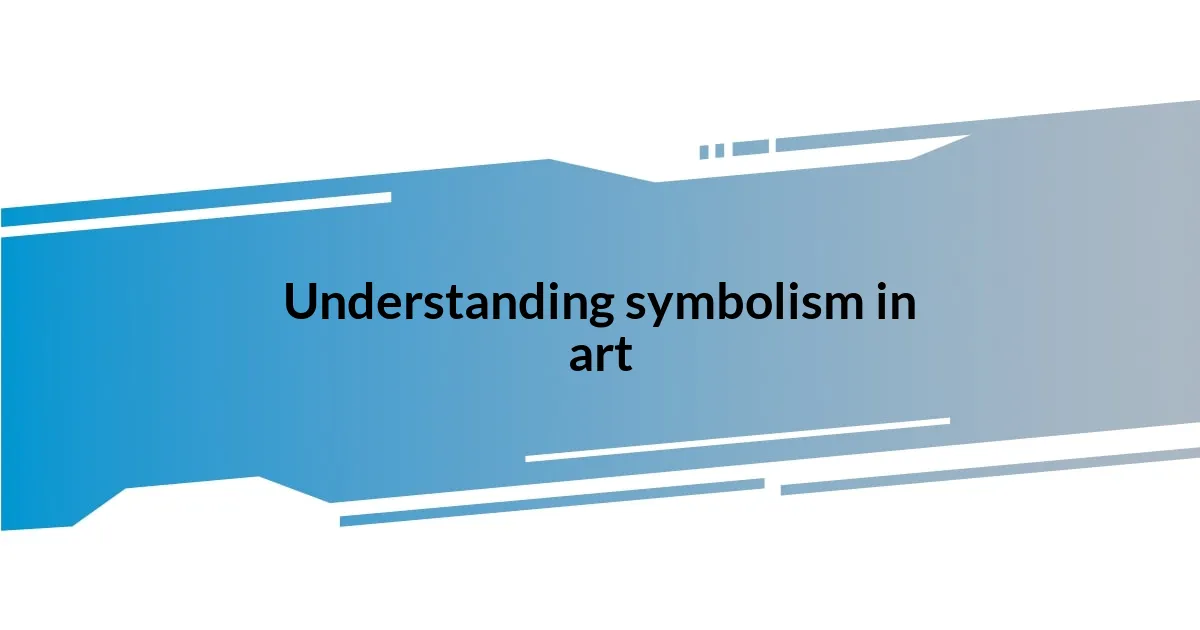
Understanding symbolism in art
Symbolism in art is a fascinating way to express deeper meanings beyond the surface. I remember the first time I encountered a piece filled with hidden symbols; it felt like discovering a secret language. This revelation made me realize that every color, shape, and object can convey ideas and feelings that resonate on a personal level.
When I reflect on my own experiences, I think of how a simple image—a blooming flower—can symbolize growth and transformation. It can evoke emotions tied to personal journeys, reminding me of moments where I’ve evolved or faced significant changes. Have you ever looked at a piece of art and thought, “What was the artist really trying to say?” That’s the beauty of symbolism; it invites us to dig deeper, turning a passive viewing into an engaging exploration of themes and emotions.
There’s a level of intimacy that comes with understanding symbols in art. I’ve often felt a connection with artists who draw from similar experiences, like using fragments of their lives as metaphors. For instance, a jagged line might signify struggle, while a smooth curve could represent healing. This interplay of symbols can transform our perception of art, allowing us to derive personal meaning and share a unique dialogue with each piece.
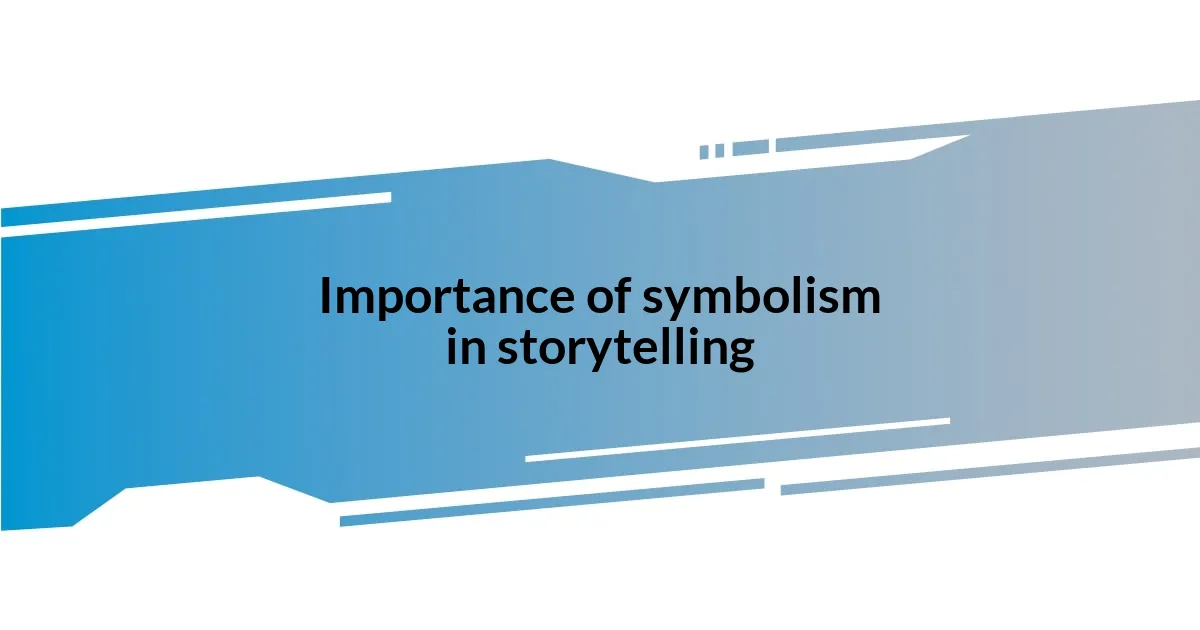
Importance of symbolism in storytelling
Symbolism in storytelling is crucial as it enriches the narrative, adding layers of meaning that engage and resonate with the audience. In my own writing, I often use symbols to convey complex emotions without explicitly stating them. For instance, a character’s broken watch might represent life’s unpredictability, instantly prompting the reader to consider the implications of time in their own lives.
Additionally, using symbolism allows readers to connect with the story on a personal level. I recall writing about a withering tree in a scene, which mirrored a character’s internal struggle. It struck me how artfully this symbol evoked feelings of loss and despair, making the emotional impact even more profound. It fosters a richer understanding, inviting readers to interpret the symbols based on their reflections and experiences.
Moreover, symbols can evoke nostalgia or provoke thought, making stories memorable. When I think about the recurring motif of the sea in my work, it often symbolizes both freedom and chaos. This duality speaks to my own journey, as I’ve often felt both liberated and overwhelmed by life’s tides. Such symbols serve as anchors, reminding readers of their shared human experiences.
| Aspect | Details |
|---|---|
| Engagement | Symbols invite deeper exploration beyond the literal meaning. |
| Connection | They create an emotional bond between the reader and the narrative. |
| Memorability | Symbolic elements can make a story more impactful and relatable. |
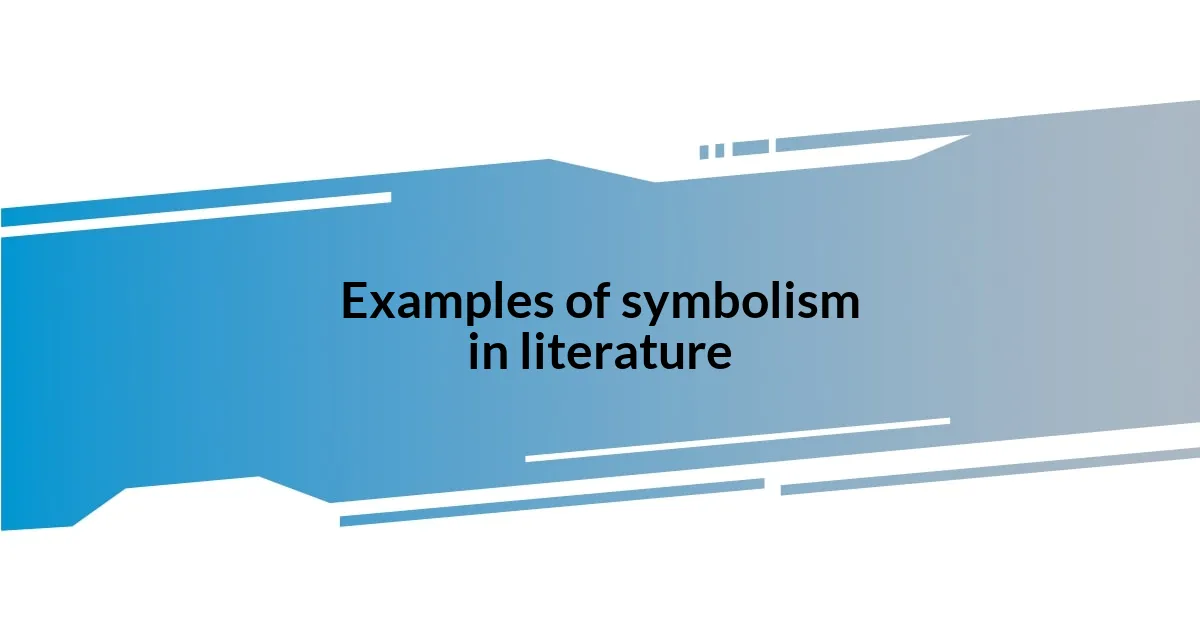
Examples of symbolism in literature
Symbolism in literature can bring depth and resonance to a story, as it allows readers to see themes wrapped in relatable imagery. For me, symbols often arise unexpectedly, such as a red rose in a scene that represents not only love but also the inevitable pain that comes with it. This duality struck me vividly during a workshop where a fellow writer unveiled how his character’s journey mirrored the life cycle of a tree—thriving in spring but bare in winter. It drove home the sentiment that, just like nature, we each experience seasons of growth and dormancy.
To illustrate the impact of symbolism, here are a few cherished examples that have left a mark on my understanding of literature:
- The Green Light in “The Great Gatsby”: It symbolizes unattainable dreams and the elusive nature of the American Dream.
- The Mockingbird in “To Kill a Mockingbird”: It represents innocence and the idea of protecting what is good in the world.
- The Conch Shell in “Lord of the Flies”: A symbol of civilization and order, its gradual destruction mirrors the group’s descent into savagery.
Each of these symbols provides a window into the characters’ struggles and the larger themes at play, reminding me of how powerful nuanced details can be in enhancing a reader’s experience.
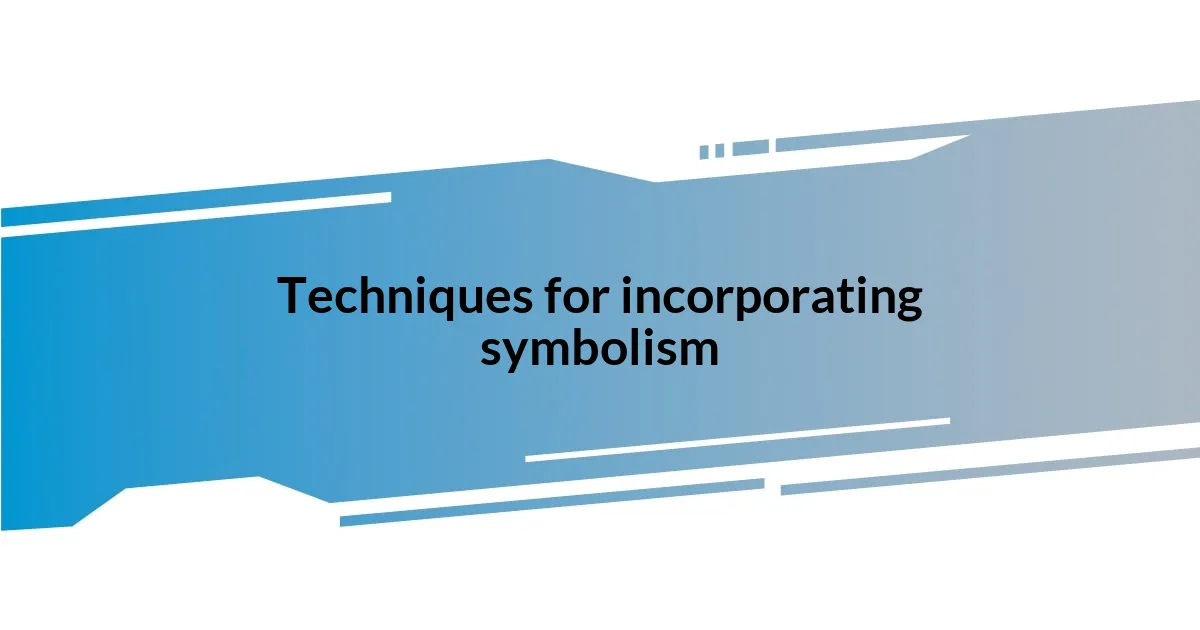
Techniques for incorporating symbolism
Incorporating symbolism into my work often begins with identifying a core theme I want to explore. I remember a story where I needed to convey the idea of hope amid despair. I chose a simple candle flickering in a dark room. That imagery allowed me to convey resilience without having to spell it out. Isn’t it fascinating how a small object can carry such weight?
Another effective technique I’ve found is to create recurring symbols throughout a narrative. For instance, in one of my pieces, I utilized an old photograph that the protagonist clings to. It became a symbol of lost connections and nostalgia, appearing at critical moments to underscore emotional transitions. As I wrote those scenes, I wondered—how often do we hold onto tangible reminders of the past to navigate our present?
Lastly, I often play with contrasting symbols to highlight internal conflicts within my characters. I vividly remember depicting a character torn between a lush garden symbolizing life, and a barren landscape representing despair. This juxtaposition provoked an emotional crisis for the character, mirroring my own experiences with choices. Reflecting on these moments prompts me to ask—for every decision we make, what symbols do we carry that reflect our inner turmoil? Through this exploration, I strive to offer readers not just a story, but a layered journey of understanding.
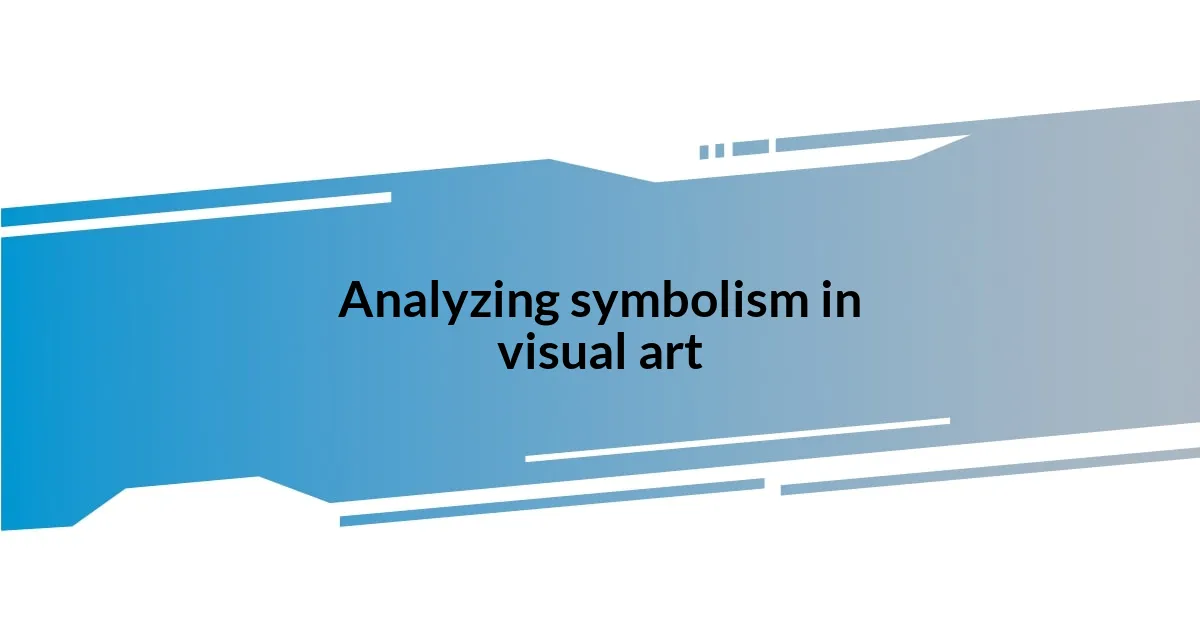
Analyzing symbolism in visual art
When analyzing symbolism in visual art, I’ve noticed how colors and shapes can evoke emotions even before we consciously interpret them. For example, I once visited a gallery where an artist used stark black and white contrast to depict the struggle between hope and despair. That combination struck me deeply, leading to an emotional response that lingered long after I left. Have you ever felt a similar pull from a piece of art?
Take, for instance, how certain recurring motifs can create a narrative within a single artwork. I remember admiring a painting that featured an open window in various contexts—sometimes illuminated by warm sunlight, other times shrouded in shadow. This element became a symbol of opportunity and isolation, making me contemplate the choices we face between stepping into the light or staying in the dark. Isn’t it intriguing how one symbol can shift meanings based on its placement?
Additionally, I believe that the context of the artwork plays a crucial role in interpreting symbolism. I reflect on a stunning mural depicting a phoenix rising from ashes, which resonates with the universal theme of rebirth. As I stood before it, I imagined the countless struggles and triumphs behind its creation. This made me wonder—how often do we overlook the backstory behind a piece of art, missing the rich symbolism that connects us to the artist’s journey? Each experience like this adds layers to my understanding of visual art, enriching my own creative process.
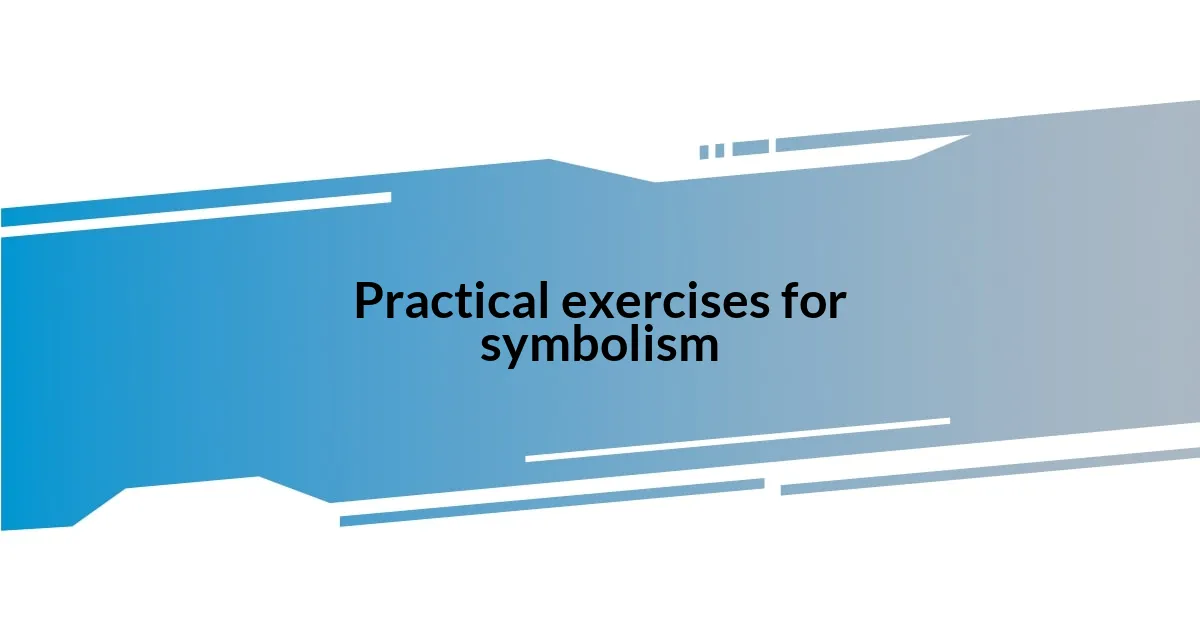
Practical exercises for symbolism
One practical exercise I often employ is the “symbol journal,” where I dedicate a page to a specific symbol that resonates with me. I jot down feelings, memories, and even dreams associated with that symbol. For instance, when I explored the image of a key, I found it represented both unlocking potential and the fear of facing hidden truths. Have you ever thought about how a simple object could carry such a duality?
Another technique is to visualize the progression of a story by creating a symbolic map. I once sketched a journey that mirrored my character’s emotional development using paths and landmarks as symbols. For example, a winding path represented confusion, while a clear road signified clarity. This approach helped me see how symbolism functions not just as decoration, but as a crucial element in driving the narrative forward. Isn’t it enlightening to think about how our characters physically and emotionally navigate their worlds?
I also enjoy the exercise of symbol swapping. I’ll take a symbol well-rooted in my work and replace it with an unexpected counterpart. For example, instead of using a heart to represent love, I might choose a compass to signify direction in relationships. This shift incited new ideas and deeper meanings in my writing. Would you believe how a simple change can open up a whole realm of interpretation? Engaging with symbols in such a dynamic way invites fresh perspectives, ultimately enriching my work.
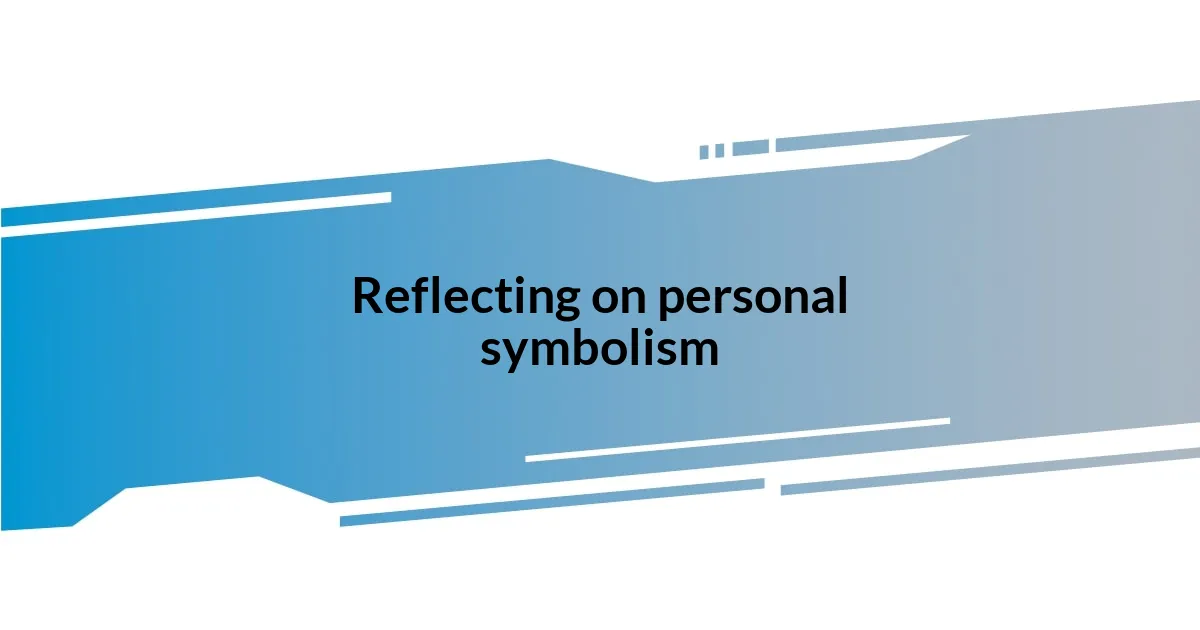
Reflecting on personal symbolism
Reflecting on personal symbolism often feels like peeking into my own subconscious. For instance, I’ve always had a fascination with water as a symbol. It reminds me of both serenity and turbulence; when I stand by a calm lake, it evokes peace, while crashing waves at the shore stir up feelings of chaos and change. Have you ever noticed how a simple element can encapsulate such powerful emotions?
In my own work, I tend to gravitate towards symbols that resonate with my personal journey. Take the butterfly, for example—its metamorphosis reflects my own experiences of growth and transformation. I distinctly remember a time when I was facing a significant life change, and I came across a butterfly fluttering by. It felt like a sign that embracing change is as natural as the seasons themselves. Isn’t it profound how certain images can mirror our internal struggles?
As I explore symbolism, I often find myself asking: what story does this symbol tell about me? The compass, for instance, has become prominent in my reflections. It symbolizes guidance and the quest for direction in both my life and creative endeavors. I’ve experienced moments of uncertainty where I needed that internal compass to help me navigate through turbulence. It’s fascinating how these symbols can evolve, becoming more meaningful as I grow and change. Have you ever considered how the symbols in your life shape your personal narrative?